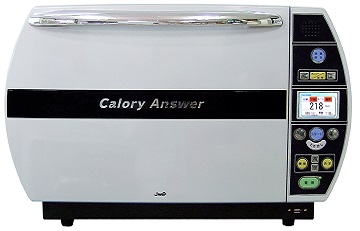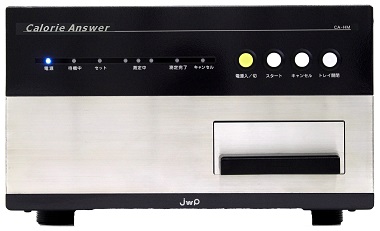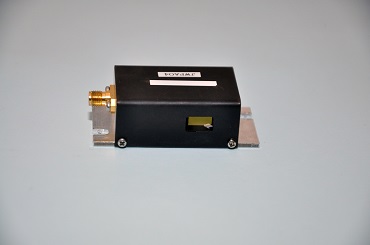Web Japan > Trends in Japan > Tech & Life > To see calories by “invisible rays”: An automatic measuring machine that uses near infrared rays
To see calories by “invisible rays”: An automatic measuring
machine that uses near infrared rays

“Calorie Answer” - a machine that measures the calories in food, that anyone can easily use (courtesy of Joy World Pacific)
These days we need to pay attention to our daily diet and ensure balanced nutrition and proper calorific intake in order to live a healthy life. In Japan we have developed measuring instruments that can instantly detect how many calories are in the food we consume daily; instruments that are used predominantly by food manufacturers and research institutes.
Just pop the ingredients in to get a measurement
Although the calories are listed on processed foods, etc., ordinary households find it difficult to check the calories and nutritional elements of every meal; meals that are prepared with a variety of ingredients.
In hospitals experts such as registered dietitians provide meals for in-patients that have the appropriate amounts of calories and nutrients calculated per food-type as stipulated by the Japanese authorities (in the Standard Tables of Food Composition in Japan.) However, this is not something that is easy to do for ordinary people who lack the expertise.
Given this, the world's first "device for measuring food calories" was developed in Japan in 2004, allowing anyone to easily measure the calories in meals served up at the dinner table. If you put the ingredients in the box-shaped device that resembles a microwave oven, you can instantly tell the number of calories and values for the three major nutrients (i.e., proteins, lipids, and carbohydrates). The device was jointly developed by Aomori Prefectural Industrial Technology Center and a lens assembly manufacturer based in Aomori.
The first model of the "Calorie Answer" which measures calories (left) and the latest slim-line model (courtesy of Joy World Pacific)
Its characteristic feature is that it uses "near infrared" rays that are invisible to the human eye to take the measurements. When the rays hit the food, the number of calories and the amount of the three major nutrients are automatically displayed. The device reads how much the near infrared rays are absorbed by the food and automatically calculates the calories from the degree of absorption (i.e., the degree to which the rays are absorbed). The reason we can work out the calories from the degree the rays are absorbed is due to the huge amount of "data for automatic calculations" that has been input into the installed computer in advance.
A maximum of 5 minutes to obtain a measurement
This "data for automatic calculations" was compiled from the actual examination of approximately 900 foods of various kinds, which were inspected one by one. Chemical analysis was used to gain an understanding of the calories in each food, which was then linked to the degree to which the rays penetrated that particular food. In addition, published information (such as the calories in confectionery listed by leading confectionery manufacturers) was checked for reliability and while this was being done, a reference data base able to handle a large number of food measurements was created over a period of approximately 3 years.
It takes roughly 3-5 minutes to take the measurements, depending on what you want to examine. As well as the number of calories and amounts of the three major nutrients, you can also tell the moisture and alcohol content. The device can also measure the weight of the food at the same time, allowing it to display an accurate value that corresponds to the weight of the food that is right in front of you; this means that you do not need to adjust the displayed numerical value by the weight of the food.
According to the manufacturer that developed the measuring device, there are approximately 300 units in use, not only in supermarkets that sell food, but also at food manufacturers and in universities/research institutes etc.
Unfortunately, it seems that the relatively high price of the device has largely prevented any spread in its popularity among ordinary households, despite the fact that it has been more than ten years since it was developed. And the reason it sells for such a high price is because the components that create the near infrared rays are expensive. The key to making it more popular among ordinary households is to cut the cost of procuring components through mass production.
One of Japan's leading electronics manufacturers exhibited a calorie measuring device whose practical application is aimed directly at ordinary households at "CEATEC Japan 2017" Asia's largest international exhibition of IT technology & electronics, held in Chiba Prefecture in October 2017.
This device also uses near infrared rays and is able to quickly and easily measure the calories and proteins/lipids/carbohydrate content in each meal.
In addition, this device also has a service feature that allows it to suggest menus tailored to the user. When you continuously eat low calorie meals for dieting purposes, ultimately you often end up just eating the same things. Therefore, this device has been designed to allow users to control their calories, while also continuing to enjoy their diet with a variety of menus.
And it is not only useful for dieting; it is also convenient for diabetic patients who need to manage their diet at home on an on-going basis, as it allows them to easily tell the calories in each meal. There is also a feature that allows you to automatically record and manage data on calories and nutrients that have been measured, so you can always refer to the data when checking your eating habits.
An app to manage nutrition
Recently there has been an increase in the “nutritional management/diet apps” for smart phones. In one of the most popular apps, you take a photo of your meal with a smart phone and it displays the number of calories and amount of carbohydrates and proteins. Using more than seven types of graph, it also shows you changes in body weight and body fat, etc., in a format that is easy to understand. The mechanism uses AI.
Another app displays and records the number of calories according to the amount of each type of food in a meal from the image data in a photograph.
If you carry a smart phone, both these apps can also be used when dining out; so in the future they are likely to see an increase in users.

Smart phone screen shot from "Calomeal" - a health management app that shows calories etc. from photographs of meals. A screen shot of "Foodlog" which shows your body weight, percentage of body fat and nutritional balance and calories per day etc.





